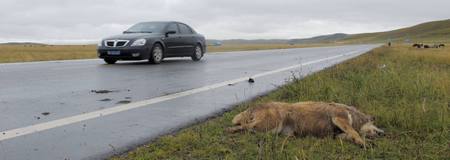Dead yak in the middle of the road
Mapping the evidence
"Stop! There's another one!" Shen yelled.
He jumped from the black van, took photos and used his GPS to record a dead bird's location.
"Animals will not change their migratory routes to make way for the highway, it is just not in their genes," Shen told the Global Times.
 |
|
A Tibetan dog lies dead on National Highway 213 after it was struck by a hit and run vehicle on September 2010. |
Not long ago, it was the death of a Chinese desert cat (also known as a Chinese mountain cat) that saddened him, yet also spurred his interest in doing field studies to better understand why vehicles hit animals.
"I had been looking for a desert cat for a long time, but the first time I saw one was its smashed body on a road," he said.
"If an animal as fast and agile as a cat gets hit by vehicles, how can other animals avoid getting hit?" he asked.
On September 27 alone they recorded the bodies of five birds, two frogs, one rabbit and one dog.
"Look at the skid marks, some are as long as 20 meters," said Shen, pointing outside of the window. "You can image how the drivers react when an animal dashes out on the road."
Shen said that if animals can't be educated on how to cross safely, at least drivers can learn to drive more carefully.
"We suggest that some enforced slowdown facilities should be set at roadkill hot spots, as well as electronic message signs," he said. "And the speed limit should be reduced to 60 kilometers per hour (kph)."
 0
0 







Go to Forum >>0 Comments